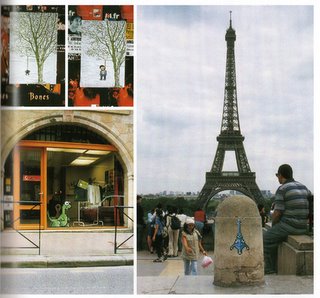[no. 006] Street Logos
Over the Winter Break I bought a book called Street Logos by Tristan Manco. It is about how traditional graffiti like tagging, has been transformed into an art form with a free-for-all kind of attitude. “Spontaneous doodles have run riot as sketchbooks are swapped for street corners.”
One category of street art is signs. Originally, graffiti artists were making statements by painting over the signs of the city, in an effort to reclaim the city space that has been conquered by consumerist advertising. However, in more recent years, graffiti artists have been using the aesthetics of signage to create their own marks, as such aesthetics “represent order, authority, consumer culture and the way our lives are
 regulated.”
regulated.”Iconographics is another category of street art. Manco makes the argument that “people have become immune to tagging, so when an artist starts using an image instead we suddenly take notice. This is very true, we are so accustomed to seeing some name or word tagged on a wall, that it hardly turns our head, but when we see an image of something drawn onto a wall, it grabs our attention, even if just for a second.
There are a few artists’ works which I thought were of particular interest such as Pixel Phil whose style is to mimic the pixilated figures we might see on a computer screen. He uses these figures to make jokes, juxtaposing these digital figures with reality. He considers the location before he creates his characters. I think that we often get caught up in the drama of life, and sometimes don’t have the time or effort to see the brighter side of it. But Pixel Phil creates these visual parodies that are carefully thought out to deliver a humorous message without too much thinking involved. Another iconographic artist that I found to be interesting was Plug. He paints the European standard two-pin plug onto “machines or objects on the street so that they can look unplugged, symbolizing the shutting down of the system.”



All these artists are making statements, whether they be personal or political. Graffiti is a channel that they are using because it is very public and there are so many statements that can be made about our society on the very streets that we see on an everyday basis. Further, these artists are not just taking images from their imagination or otherwise, and plopping them anywhere they please, they have taken consideration into the form of their images and how they can be integrated into their environment, creating some narrative or commentary about existing conditions.


2 Comments:
Graffiti is a channel for artist to express themselves to a particular audience depending on its location within the public space. I find that concept pretty interesting that anyone can be communicator of ideas to a public collective and spawn all sorts of reactions and questioning.
FOR EX. with "Obey" Shepard Fairey posted his icon of the Andre the giant in public spaces and it caused a reaction. People started to question its meaning. Obey who? Obey what? Obey when? Obey why? Ultimately it was digested by many people because of the modern san serif typeface he used and the simplification of form with the head of the Giant in a rectangular module. People started to identify with the icon because was easy to remember, and digest. It became a logo or Icon of Shepard Fairey's work in freeing public space for the individual.
1:14 PM
Your blog gave me another perspective on grafitti. These artists use grafitti in a non-offensive manner. It is very different than the grafitti that we are so used to seeing on the streets that are done by gangs and people with no respect for property. When I think of grafitti, I think of it being done quickly and with little or no consideration as to what property it is being applied to, so it was interesting to read that the grafitti artists featured in your blog actually take great consideration in their grafitti art. They want to communicate a strong, intelligent message opposed to just doing it to glorify their gang or themselves.
I thought that the little figures on the stairs were so funny! And the unplugged grafitti looks so real that it creates an interesting play with your eyes and mind. Grafitti can actually be a very effective way to communicate messages to the vast public through art. If it was in a museum, then only people who chose to see the exhibit would see it, but in public, it is there for everyone to see, even if they dont want to see it.
10:32 PM
Post a Comment
<< Home